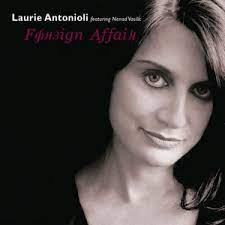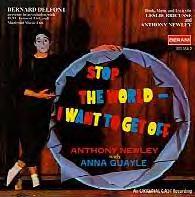
Daily Dose Of Jazz…
Laurie Antonioli was born on March 9, 1958 in Marin County. California. At the age of sixteen she began playing guitar and performing primarily her own original music as well as that of the singer-songwriters of the era. In 1975 she won the American Songwriters Contest for high school students, studied jazz at Mt. Hood Community College in Gresham, Oregon and Cal State Long Beach. She took private lessons from Mark Murphy and Joe Henderson.
After graduation, Laurie continued composing and performing. In 1980 she toured Europe for eight months with New Orleans saxophonist Pony Poindexter. When he suffered a stroke, a record date in Paris with pianist Kenny Drew was canceled and they were unable to finish out their tour. Laurie brought Pony back to California where she lived and led her own bands based out of San Francisco.
1985 saw Antonioli signing with Catero Records and her first album was the live two-track Soul Eyes, with the title song given to her by composer Mal Waldron. She was accompanied by pianist George Cables. After a hiatus from music, she settled in Vienna, Austria from 2002 to 2006 and began recording again.
Her Nabel Records album Foreign Affair was a Balkan jazz hybrid recorded in Slovenia with musicians from Serbia, Albania, Germany, and the U.S. It was well received in Europe. Her next album The Duo Session enlisted Richie Beirach where she wrote lyrics to his compositions. Laurie also wrote lyrics to some Miles Davis tunes and free improvisation pieces. This recording was also well-received but like Foreign Affair was known primarily to European audiences.
As an educator she held the position of Professor of the Vocal Department at KUG University’s Jazz Institute in Graz, Austria from 2002 to 2006 while living and performing in Europe. Antonioli was offered a position at the California Jazz Conservatory in Berkeley, California as the school’s vocal program director and created an eight-semester vocal performance curriculum. Singer and record producer Laurie Antonioli, who between 1985 and 2018 she has recorded seven albums, continues to perform and record.
More Posts: educator,history,instrumental,jazz,lyricist,music,vocal

Daily Dose Of Jazz…
Dee Bell was born in Fort Wayne, Indiana on July 16, 1950 and grew up in a musical family and began playing music at home. She played clarinet in the Plainfield High School band and performed in an a cappella trio from age ten through her last year of high school. She went on to enroll and graduate from Indiana University in 1972, lived on the edge of the Hoosier National Forest in a two-room cabin with a wood stove for heat, and was co-founder and head chef of the Earth Kitchen vegetarian restaurant in Bloomington, Indiana.
The late 1970s saw Bell moving to California and working at a restaurant in Sausalito. While singing Happy Birthday to a customer, she was heard by jazz guitarist Eddie Duran who invited her to sing with his band. They made a demo tape which became her first album, Let There Be Love on the Concord Jazz label, that included saxophonist Stan Getz. Their sophomore album for Concord Jazz brought in trumpeter Tom Harrell.
Bell recorded a third album, Sagacious Grace in 1990 with Houston Person and John Stowell, but was never released due to technical problems until 2011 when audio engineers fixed the problem. It reached No. 31 on the JazzWeek radio chart.
Bell left the music business and became a grade school music teacher in Mill Valley. After the death of her musical director, Al Plank, she met Marcos Silva backstage at a tribute to Merrilee Trost. This became a collaboration, merging her swing style with his Brazilian rhythms, resulting in the recording of three CDs by them.
With permission and copyrights Bell has written lyrics to Billy Strayhorn’s Isfahan, Jimmy Rowles The Peacocks, Don Sebesky’s You Can’t Go Home Again, and Ivan Lins’ Acaso (By Chance), Depois dos Temporais (After the Storm), and Choros das Aguas (Crying of the Waters).
Vocalist Dee Bell, who has released six albums and has been nominated for several awards by Down Beat, Billboard and BAM, continues to perform.
More Posts: bandleader,history,instrumental,jazz,lyricist,music,vocal

Daily Dose Of Jazz…
Jerry Ross was born Jerold Rosenberg on March 9, 1926 in Bronx, New York to Russian parents of the Jewish faith. Growing up, he was a professional singer and actor in the Yiddish theater. Following high school, he studied at New York University under Rudolph Schramm and introductions to singer Eddie Fisher and others brought him into contact with music publishers at the Brill Building, the center of songwriting activity in New York.
Ross met Richard Adler in 1950 and as a duo they became protégés of composer, lyricist, and publisher Frank Loesser. They began their career in the Broadway theater with John Murray Anderson’s Almanac, a revue for which they provided most of the songs, resulting in recordings of Acorn in the Meadow by Harry Belafonte and Fini by Polly Bergen.
Their second effort, The Pajama Game, opened on Broadway in May 1954. It ran for 1063 performances, produced the jazz standard Hey There, won a Tony Award, Donaldson Award and the Variety Drama Critics Award. Two songs from the show,
Their next musical, Damn Yankees, opened on Broadway in 1955, starring Gwen Verdon. It ran for 1019 performances and produced the jazz standard Whatever Lola Wants, and won the Tony Award for Composer/Lyricist and Musical.
Composer and lyricist Jerry Ross, who wrote, alone or in collaboration more than 250 songs and was entered posthumously into the Songwriters Hall of Fame, transitioned on November 11, 1955, at the age of 29, from complications related to the lung disease bronchiectasis.
More Posts: composer,history,instrumental,jazz,lyricist,music,vocal

Daily Dose Of Jazz…
Haven Gillespie was born James Lamont Gillespie on February 6, 1888 in Covington, Kentucky, one of nine children of Anna (Reilley and William F. Gillespie. The family was poor and he dropped out of school in grade four to unsuccessfully find a job. His older sister, Lillian, who had married a printer in Chicago, Illinois offered him a job and in 1902 left home for the bustling city life.
A few years later, corresponding with a childhood sweetheart back in Covington, a forthcoming proposal led to marriage in 1909. With sixteen dollarsbetween the two of them, Gillespie soon landed a job as a typesetter for the Cincinnati Times-Star, ultimately maintaining his membership in the International Typographic Union until his death. He found work as a “plug” man, entertaining audiences at local vaudeville shows by playing and singing songs he had written.
His first break came in 1911 when he met Roy Steventon, performing with Mildred Lovejoy in a dancing act and teaming up they composed three songs for the act, You’re Just The Girl I’ve Met In My Dreams, When I Am Gone, and Winter Time Is Coming Around Too Soon. Though Haven was paid one and a half cents for each piece of sheet music sold, royalties only amounted to a few dollars over the next several years.
While touring to promote his songwriting, Gillespie began drinking heavily and would struggle with alcohol addiction most of his life. At age 23 and after a long night of drinking, he met Joe Ford, a printer with the Cincinnati Tribune. Ford took Haven home to sober up and the two men eventually developed a lifelong friendship.
Gillespie’s first major hit came in early 1925 with Drifting and Dreaming. He left for New York and became a journalist and composer of songs for vaudeville shows. He first gained notice in 1925 with collaborators Egbert Van Alstyne, Ervin R. Schmidt, and Loyal Curtis on Breezin Along With The Breeze, which was recorded by Josephine Baker, among numerous others.
He successfully collaborated with J. Fred Coots, Mitchell Parish, Henry Marshall, Henry and Charles Tobias, Neil Moret, Peter DeRose, Victor Young, Jack Little, Richard Whiting, Rudy Vallée, and Beasley Smith, to name a few. His Louisiana Fairy Tale, recorded by Fats Waller, was used as the first theme song in the PBS Production of This Old House.
Tin Pan Alley composer and lyricist Haven Gillespie, whose songs You Go To My Head, Beautiful Love and Santa Claus Is Comin’ To Town have become jazz standards, transitioned on March 14, 1975 in Las Vegas, Nevada.
More Posts: composer,history,instrumental,jazz,lyricist,music

Daily Dose Of Jazz…
Leslie Bricusse was born on January 29, 1931 in Pinner, Middlesex, England. He was educated at University College School in London, England and then at Gonville and Caius College, Cambridge. While at Cambridge, he was Secretary then President of Footlights and during his college drama career he began working for actress, singer and comedian Beatrice Lillie.
In the 1960s and 1970s, Bricusse enjoyed a fruitful partnership with Anthony Newley. They wrote the musical Stop the World – I Want to Get Off in 1961,that became a film in 1966. In 1965 they wrote the show The Roar of the Greasepaint – The Smell of the Crowd and music for the film Willy Wonka & the Chocolate Factory in 1971. For the latter, they received an Academy Award nomination for Best Original Song Score.
Solely as a lyricist, Leslie collaborated with composer Cyril Ornadel on Pickwick, Henry Mancini on Victor/Victoria, Tom and Jerry: The Movie, and with John Williams on Hook. As composer and lyricist he scored the film, Doctor Dolittle and received a 1967 Academy Award for Best Original Song for Talk To The Animals, and Goodbye, Mr. Chips in 1969.
Of his many songs a few that have become jazz standards are What Kind of Fool Am I?, Who Can I Turn To?, Feeling Good, My Kind of Girl, Two For The Road, If I Ruled the World, Can You Read My Mind, When I Look in Your Eyes, and Pure Imagination.
In 2015, he released his memoir, Pure Imagination: A Sorta-Biography, with a foreword by Elton John. Composer, lyricist, and playwright Leslie Bricusse, who was awarded the Order of the British Empire, transitioned on October 19, 2021 in Saint-Paul-de-Vence, France at the age of 90.

More Posts: composer,history,instrumental,jazz,lyricist,music,playwright





